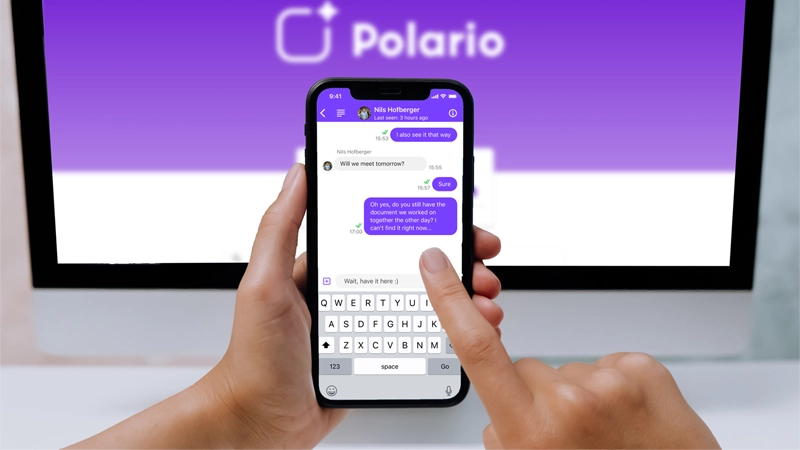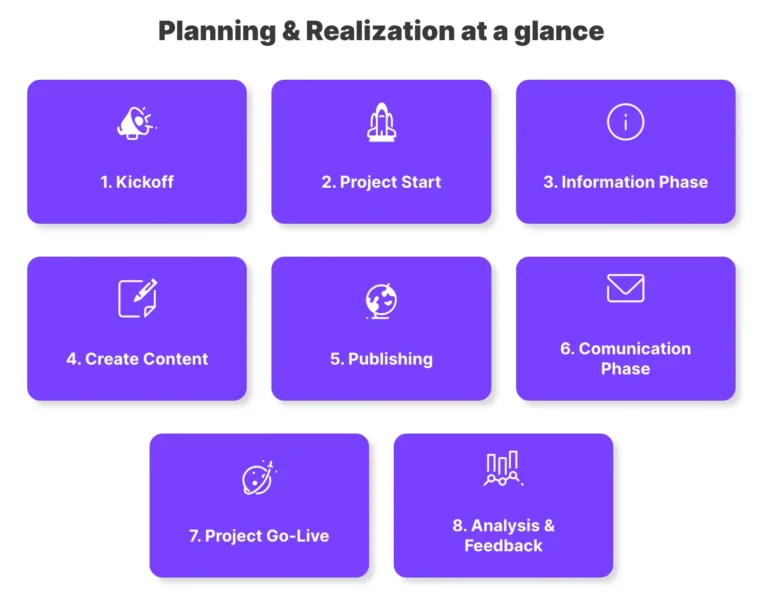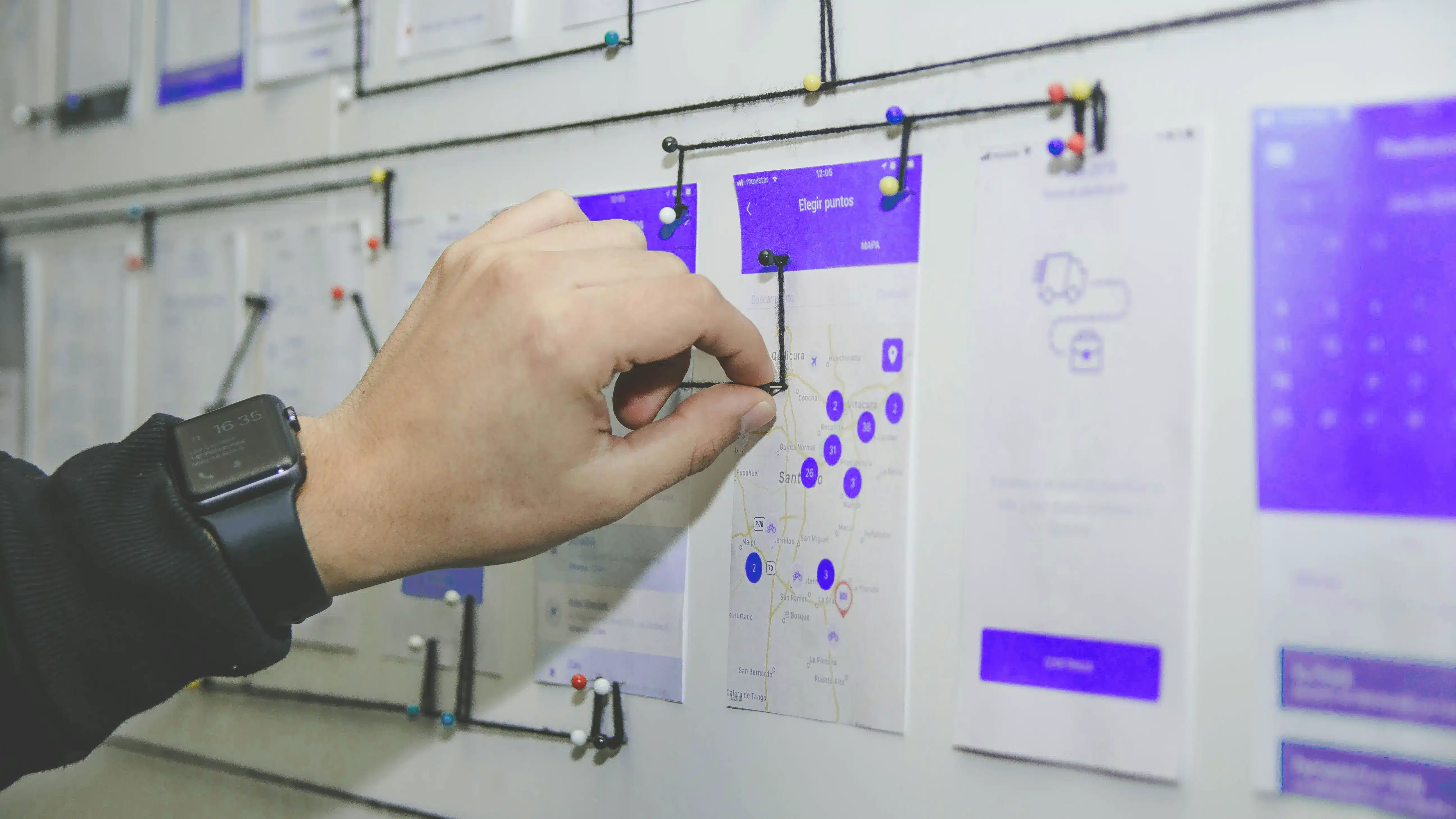Where efficient and effective communication often makes the difference between company success and stagnation, the implementation of an employee app is a crucial strategy for optimising internal processes. Employee apps have proven to be a crucial tool in overcoming these challenges by simplifying communication, strengthening employee loyalty and optimising operational processes. Such apps offer platforms for everything from day-to-day communication to comprehensive project management functions. They also have the potential to fundamentally change the way teams work together.
Despite the obvious advantages, the introduction of such technology is not a trivial endeavour. Implementing an employee app requires careful planning, consideration and strategic management. Companies not only have to master the technical side of the introduction, but also take cultural and organisational challenges into account. Employees must be convinced of the benefits and involved in the process in order to ensure success.
This comprehensive guide will take you through the entire employee app implementation process: From the initial planning phase to selecting the right technology, training and final implementation. We will also discuss proven strategies on how to increase acceptance among your employees and how to ensure the long-term success of your investment. Ultimately, this article will not only highlight the practical aspects of introducing an employee app, but also show how such a tool can help to promote a lively and committed corporate culture.
Basics and target definition before implementing the employee app
Before you dive into selecting and setting up the technology, you first need to understand and analyse the specific needs of your company. Start by having conversations with various stakeholders – including executives, team leaders and end users. Are the communication channels too slow or inefficient? Is there a lack of a centralised system for task management? Or do employees need an easier way to give and receive feedback? These discussions can provide valuable insights into what challenges and bottlenecks exist in the current communications landscape and how an employee app could help overcome them.

The purpose of an employee app
An employee app pursues the interests of the company as well as those of the employees. We explain the purpose of an employee app.
Once you have a clear picture of the company’s needs, the next step is to set specific and measurable goals for the implementation of the employee app. These objectives can be many and varied – from increasing internal communication efficiency to improving the flow of information and increasing employee commitment. It is important that each goal is clearly defined and ideally quantifiable in order to be able to measure the subsequent success of the app. For example, a goal could be to reduce the time it takes to communicate information to the entire team by 30%, or to improve employee feedback via internal communication channels by 50%. By setting this initial objective, you ensure that the implementation of the employee app is targeted and creates real added value for your company.

Focus on internal communication: secrets of success and proven strategies
Strengthen your company’s internal communication. Definitions, success stories and more. Your guide to effective strategies.
Choosing the right platform
When evaluating different providers, it is important to carry out a comprehensive comparative analysis that takes several key criteria into account. A comprehensive overview and in-depth analysis of various providers has already been presented in one of our previous blog posts, where you can also download a detailed white paper on the topic.
In this comparison, you should pay particular attention to four key evaluation criteria: Ease of use, functionality, security and cost. Firstly, user-friendliness should take centre stage. An intuitive user interface is crucial so that all employees, regardless of their technical expertise, can use the app effectively. The functionalities of the app must also be scrutinised. The question here is whether the app fulfils the specific requirements of your company, such as real-time communication, task management or integration with existing systems. Security is another criterion that should not be underestimated, especially as data security and data protection are of the utmost importance.
Ensure that the provider offers robust security measures such as end-to-end encryption and regular security audits. Finally, the costs must not be ignored. It is important that the cost structure is transparent and fits into your company’s budget without compromising on other important aspects. By thoroughly evaluating these criteria, you ensure that the implementation of your employee app is based on a solid and functional foundation. You can find our specific recommendations and more in-depth discussions in our blog post “Requirements for an employee app“ and in the associated white paper “Terms of reference for an employee app”, which can be downloaded free of charge.
Data privacy and security
Companies must ensure that the employee app complies with the applicable data protection regulations, which is not only a legal must, but also a core concern of employee trust. In the European Union, for example, all employee apps must comply with the General Data Protection Regulation (GDPR), which regulates the processing of personal data. This means that the employee app must be designed in such a way that it only collects and processes the data that is absolutely necessary for the intended purposes. In addition, users must be informed about how their data is used and they must actively consent to the use of their data. To understand the practical implementation of these data protection and security guidelines and to find out how company-wide and data protection-compliant employee communication can work effectively, we recommend you take a look at our detailed blog post.

Company-wide & data protection-compliant employee communication
Employee communication needs to be better approached. Learn how this can be done quickly and effectively via an employee app.
In addition to the legal requirements, the security features of the employee app must be robust enough to protect all data from unauthorised access. This includes end-to-end encryption for data transmission, secure authentication mechanisms, regular security audits and the ability to respond quickly to a suspected data breach. In addition, the employee app should offer access control functions so that only authorised personnel can access sensitive information.
Choosing an employee app with strong data protection and security features is not just a question of compliance, but also an investment in the corporate culture. Employees who can trust that their data is secure will be more willing to adopt and use the app, ultimately leading to a more open and efficient working environment.
Implementation strategy for an employee app
A well thought-out implementation strategy is the backbone of any successful introduction of an employee app. The process can be roughly divided into several phases. First comes the planning phase, in which the foundations are laid. This is where the project team defines the main objectives and draws up a schedule. It is important that all key stakeholders are involved from the outset in order to ensure support and take into account the requirements of different departments.
In the subsequent development and test phase, the employee app is trialled in a controlled environment by a selected group of users. Feedback is collected and appropriate adjustments are made. This is followed by the pilot phase, in which the employee app is tested by a limited number of users in a real company environment. This offers the opportunity to fix any final teething problems before the app is rolled out company-wide.
Finally, the employee app is introduced company-wide during the implementation phase. This is where effective communication strategies play a role in promoting acceptance and conveying the benefits of the new employee app to employees. At the same time, user support through training is essential in order to achieve a high level of application expertise.
Different teams and stakeholders are involved in each phase: From the IT department, which is responsible for the technical implementation, to the communications department, which communicates the benefits of the app, to the HR team, which manages the change management process. Not forgetting the managers, whose support is crucial to the success of the implementation, and of course the employees themselves, whose daily work is to be made easier by the app.
Careful planning and execution of these phases, involving all teams and stakeholders involved, will ultimately lay the foundation for a successful implementation of the employee app. To gain an insight into what a structured and effective employee app implementation process looks like in practice, take a look at our approach! Find out more here: https://polario.app/en/planning-realization/

Training and introduction of the employee app
Comprehensive training and carefully thought-out implementation strategies are the be-all and end-all for the successful implementation of an employee app. A customised training programme enables employees to use all the functions of the new employee app efficiently. This can take the form of workshops, online tutorials or interactive webinars. It is important that the training content is tailored to the different competence levels and roles in the company to ensure that every employee can use the app optimally.
In addition to training, a well thought-out communication strategy is crucial to promote the use of the app. The benefits of the employee app should be emphasised, best practices shared and specific examples of successful applications highlighted. Regular updates and the inclusion of feedback can also increase employee acceptance and commitment.
For more information and guidance on how to improve internal communication through effective training and strategic communication approaches, we recommend reading our blog post “10 steps to effective internal communication”. In “5 key factors for successful employee retention“, you will also find valuable insights into how you can strengthen not only communication but also employee retention in your company by specifically promoting app use.

10 steps to effective internal communication
Improve communication in your company: Follow these 10 strategic steps for effective internal communication.

5 key factors for successful employee retention
Focus on strong employee retention: Increase productivity & reduce staff turnover with proven employee retention strategies.
Evaluation and feedback
In order to effectively measure the success of the employee app, quantitative and qualitative methods must be used. Quantitative data can be collected via the frequency of use, the number of active users and the average duration of use. Qualitative evaluations, on the other hand, relate to user satisfaction and the improvement of work processes, which can be obtained through surveys, interviews and open feedback channels.
Feedback loops are essential in order to translate these findings into concrete adjustments to the employee app. User feedback provides information on which features are well received and which areas have potential for improvement. This information is invaluable for the IT team and app developers to continuously improve the application and adapt it to the changing needs of employees.
Establishing regular feedback cycles not only ensures the continuous optimisation of the employee app, but also signals to employees that their opinions are valued and that they can actively contribute to improving the company tools. This not only strengthens the bond with the employee app, but also with the company itself. In order to promote a culture of open dialogue and continuous improvement, companies must ensure that feedback is taken seriously and visibly implemented.
Future prospects and scaling after implementing an employee app
Once an employee app has been successfully implemented, the process should not be considered complete. Instead, the app must be seen as a dynamic platform that is constantly evolving and adapting to the company’s changing needs. The future prospects of the employee app depend largely on how well it can be scaled with new requirements, technological developments and the growth of the company.
A clever scaling strategy takes both technical and user-orientated aspects into account. In technical terms, this means that the infrastructure of the employee app must be designed in such a way that it can handle a growing number of users without compromising performance or security. User-orientated scaling means that new functions and tools can be integrated based on the growing and diversifying needs of employees.
For long-term planning, it is therefore crucial to regularly assess how well the employee app supports the company’s objectives and where adjustments or enhancements are required. The integration of regular user feedback is invaluable here. It enables trends and changing requirements to be recognised at an early stage and the app to be adapted accordingly.
By adopting a forward-looking attitude and continuously developing their employee app, companies can ensure that it remains a central and value-adding part of their digital working environment. Scaling is not only a question of capacity, but also of flexibility and adaptability in order to not only manage change, but to utilise it as an opportunity for innovation and improvement.
Conclusion
Implementing an employee app is a crucial step for companies that want to modernise and improve internal communication and collaboration. Our discussion has shown that it is not just a matter of selecting a suitable platform, but also of taking a strategic approach to the introduction and long-term integration of the technology into day-to-day business. One of the most important findings is that clear objectives must be defined that reflect both the needs of the company and those of the employees.
Choosing the right platform is essential and should take into account user-friendliness, range of functions, security and costs. Data protection and security must not be neglected and must be guaranteed in accordance with the applicable laws and best practices.
Training and a targeted introduction play an important role in the acceptance and use of the app by employees. You need support and guidance to fully utilise the benefits of the app.
In addition, collecting and considering feedback after the launch is crucial in order to continuously improve the app and adapt it to the company’s changing requirements. For the future, a scalable app is required that can grow and develop with the company.
Finally, we recommend that companies view the implementation of an employee app as an ongoing process that goes beyond the mere introduction of the technology. The aim is to create a culture of continuous improvement and feedback. This not only strengthens employee loyalty, but also promotes an adaptive and resilient organisation. With the right strategy, tools and attitude, implementing an employee app can be a powerful tool to effectively meet the challenges of a constantly changing working world.



